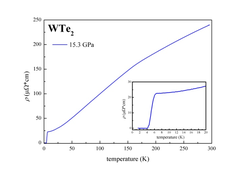Superconductivity at high pressure
Superconductivity at high pressure
The study of pressure effect on the properties of the superconducting materials can serve as a quantitative test of theoretical models and at the same time as a guide in the synthesis of new materials with superconducting properties:
(i) dependence of the critical temperature (Tc) of superconductivity on pressure can provide the ideas for increasing of Tc for a given superconductor at ambient pressure through chemical substitution (doping);
(ii) some superconducting materials can be synthesized only at the conditions of high pressure and high temperature;
(iii) many nonsuperconducting at ambient conditions materials become superconducting at high (very high) pressures.

Figure 1: Pressure induced superconductivity (maximum Tc»6 K at »16 GPa) in tungsten telluride (WTe2)
The exploration of the chemical, structural, and electronic parameters of a solid, which lead to the appearance, or the enhancement of superconductivity is an ongoing topic of intensive research. Despite intensive research in the field of superconductivity, there is no "recipe" for finding new superconducting materials. The empirical search for new superconductors is still the predominant method: every new superconductor discovered can act as a new piece in the puzzle.
Very often superconductivity appears in compounds, which are close to a structural, magnetic, or electronic instability. High pressure is a powerful tool to tune the system towards such instabilities and, therefore, in superconducting state.
Pressure evolution of the electronic transport properties of PdSe2.

(a) Application of pressure tunes the electronic properties of PdS2-type phase of PdSe2 from semiconductor to metal at pressures above 3 GPa. (b) With the structural transition to the pyrite phase, superconductivity emerges with Tc showing a dome-shaped dependence on pressure with maximum Tc of 13.1 K at P ~ 23 GPa. (c) Demonstration of the correlation between the pressure evolutions of Tc and frequencies of internal stretching vibration (Ag mode) and librational (Eg mode) modes of the Se2 dumbbells. The sudden increase of the room temperature resistivity at P = 37 GPa and the change of the temperature dependence r(T) in the normal state (a very weak temperature dependence, as illustrated by the curve at 40 GPa in (a)) indicates a structural transition to the γ-phase. The γ-phase remains superconducting (curve at 40 GPa in (a)) with Tc weakly depending on pressure. [M.A. ElGhazali, P.G. Naumov, H. Mirhosseini, V. Süß, L. Müchler, W. Schnelle, C. Felser and S.A. Medvedev, “Pressure-induced superconductivity up to 13.1 K in the pyrite phase of palladium diselenidePdSe2”, Phys. Rev. B 96, 060509(R) (2017)]

